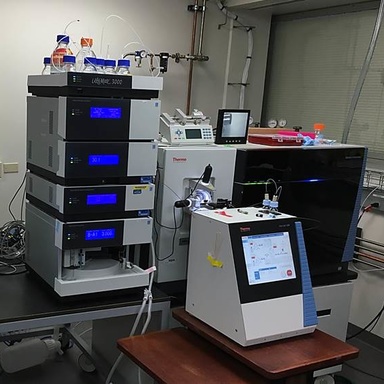Breadcrumb
- Home
- About Us
About Us
Main navigation
About The Proteomics Facility
The Proteomics Facility has state-of-the-art LC-MS/MS equipment for protein micro-sequencing, structural analysis, and quantitative studies of complex protein mixtures [LC-coupled Orbitrap LUMOS, Q-Exactive hf and Ultraflex MALDI TOF/TOF]. Staff are available to assist in the characterization of both targeted protein complexes and trace components in lysates and sera.

Unbiased protein identification relies upon data-directed MS/MS structural investigations of digest peptides. Generally, the peptides are resolved by an organic gradient running through a an anlytical nanobore column with C18 packing coupled to electrospray ionization (ESI). Decisions made in real time determine which peptides are interrogated for sequence assignment. Separations may also be conducted off-line, however, with robotic fraction collection directly to 384 micro well target plates. These are analyzed later by matrix assisted laser desorption ionization (MALDI). The plates can be stored and reexamined for up to three weeks. MALDI also enables robust detection of many biomolecules such as oligonucleotides, lipids, and glycoproteins.
Preliminary stages of biomarker discovery often require unbiased approaches to comparative proteomics. The core supports SILAC, iTRAQ, TMT and chemical labeling (by reductive amination); protocols that are often combined with 2 dimensional separations prior to MS/MS. Regulated protein expression is deduced by the distinct ratios of constituent peptides; clearly evident when two (or more) samples are analyzed simultaneously. These "wide-net" projects are run on either the Thermo Q-Exactive hf or Orbitrap LUMOS. If the target(s) of the investigation are predetermined, however, then PRM on the QExactive hf can simultaneously provide high specificity and sensitivity for several dozen compounds. Although the technique is sometimes compared with ELISA, it differs in that PRM achieves a linear response (for numerous targets) over four orders of magnitude in concentration with an RSD below 10%. The LOQ can often reach low (or sub) ng/uL. These targeted, quantitative protocols require a much greater investment in development time and should only be considered after consultations with the Facility Director.